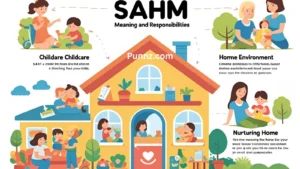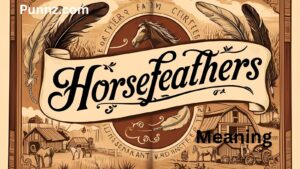If you’ve ever come across the word “horsefeathers” in a movie, book, or old-timey conversation, you may have paused and wondered, “Wait… what does that even mean?”
You’re not alone.
While it may sound like something straight out of a Wild West tale or an old-fashioned cartoon, “horsefeathers” is a real expression—and it’s more relevant than you might think.
In this article, we’ll dive into the true meaning of “horsefeathers,” its origins, its use in modern contexts, and explore 11 carefully chosen alternatives you can use depending on the tone, formality, or setting of your conversation.
Whether you’re looking to express disbelief politely or brush off nonsense with humor, we’ve got your back.
What Does “Horsefeathers” Mean?
The word horsefeathers is a humorous or euphemistic way of saying nonsense, foolish talk, or rubbish. It’s a gentle way to call something untrue, exaggerated, or simply ridiculous without sounding harsh or offensive.
✅ In simple terms:
- “Horsefeathers” = Nonsense / Baloney / Rubbish
It’s rarely used in contemporary language but can still be found in writing, film, and among people who enjoy a vintage flair in their vocabulary.
Origin of “Horsefeathers”
The phrase “horsefeathers” gained popularity in the 1920s and 1930s. It was coined and popularized by American cartoonist Billy DeBeck, best known for creating the comic strip Barney Google. The word quickly found its way into American slang as a lighthearted exclamation of disbelief or dismissal.
It was used much like “hogwash,” “poppycock,” or even “baloney”—terms that all mean roughly the same thing: that’s just not true!
Interestingly, it doesn’t actually refer to any feathers on a horse—since, of course, horses don’t have feathers. That absurdity is precisely the point: the word itself is nonsensical, making it perfect for describing things that are, well, nonsense.
How Is “Horsefeathers” Used in a Sentence?
To better understand it, let’s look at how it might appear in different contexts.
Example 1:
“You think he can fix a car blindfolded? Horsefeathers!”
Example 2:
“All that talk about the haunted house is just a bunch of horsefeathers.”
It’s playful, vintage, and perfect when you want to call something ridiculous without being too direct or offensive.
Why Use Alternatives to “Horsefeathers”?
Even though “horsefeathers” is charming and expressive, it’s dated and might confuse people unfamiliar with older American slang. That’s where alternatives come in.
You may want something:
- More modern
- Polite in professional settings
- Casual for everyday conversations
- Humorous or sarcastic, depending on tone
Let’s explore 11 alternatives to “horsefeathers” and break down when and how to use each one.
1. Nonsense
Tone: Neutral, professional
Best for: Workplace, formal writing, intellectual debate
Example:
“That’s complete nonsense. There’s no evidence to support it.”
✅ Why it works: Straightforward and universally understood, without being rude.
2. Baloney
Tone: Informal, playful
Best for: Casual conversations, family discussions, light disagreements
Example:
“You think aliens built the pyramids? That’s baloney!”
✅ Why it works: It’s light, humorous, and carries a vintage charm like “horsefeathers.”
3. Hogwash
Tone: Old-fashioned, humorous
Best for: Storytelling, sarcasm, polite disagreement
Example:
“What a load of hogwash! There’s no way that happened.”
✅ Why it works: It feels playful and vintage, great for exaggerated tales.
4. Poppycock
Tone: Quirky, polite
Best for: Literary writing, joking criticism, mild disbelief
Example:
“Absolute poppycock! That theory has been debunked.”
✅ Why it works: It’s quaint and endearing—perfect for humorous disbelief.
5. Rubbish
Tone: Slightly British, versatile
Best for: Formal or informal contexts, depending on region
Example:
“That’s utter rubbish. He’s just trying to scare people.”
✅ Why it works: Simple, clear, and can adapt to any tone depending on delivery.
6. Malarkey
Tone: Playful, expressive
Best for: Political talk, light argument, social commentary
Example:
“All that economic talk is just malarkey—they don’t have a plan.”
✅ Why it works: It adds flair while still calling something out as untrue.
7. Bunk
Tone: Informal, blunt
Best for: Youthful speech, streetwise language, sarcastic tones
Example:
“That’s bunk and you know it. You’re just making excuses.”
✅ Why it works: Quick and punchy, great for modern conversations.
8. Twaddle
Tone: Literary, soft
Best for: Creative writing, academic humor, elegant dismissal
Example:
“What utter twaddle. That’s not even logical.”
✅ Why it works: A refined, writerly way to dismiss silly ideas.
9. Garbage
Tone: Harsh, blunt
Best for: Passionate disagreement, informal arguments
Example:
“That article is pure garbage. It’s all made up.”
✅ Why it works: Direct and strong—use with caution in formal settings.
10. Bull / Bullcrap / B.S.
Tone: Strong, potentially offensive
Best for: Among friends, heated discussions, when emotions run high
Example:
“Don’t give me that bull. You’re lying.”
✅ Why it works: Emphatic and impactful—though not suitable for polite company.
11. Flapdoodle
Tone: Whimsical, outdated but fun
Best for: Creative writing, humorous speech, old-soul slang
Example:
“Flapdoodle! That’s the most ridiculous thing I’ve ever heard.”
✅ Why it works: It brings character and charm to any quirky conversation.
Choosing the Right Alternative: Matching Tone with Intent
Choosing the best word depends on context and audience. Here’s how to make the right choice:
⭐ Use “nonsense” or “rubbish”:
- In professional emails, classroom discussions, or polite disagreements.
😄 Use “baloney,” “hogwash,” or “malarkey”:
- Among friends, during casual chats or humorous storytelling.
😠 Use “garbage” or “bull”:
- When expressing strong disapproval, but make sure it fits the situation (and won’t offend).
🎩 Use “poppycock,” “twaddle,” or “flapdoodle”:
- When you want to infuse personality or old-school charm into your writing or speech.
Understanding tone is key. You wouldn’t use “bull” in a boardroom, just like you wouldn’t say “twaddle” during a heated Twitter debate (though it would be charming if you did).
Can “Horsefeathers” Still Be Used Today?
Absolutely—but sparingly.
“Horsefeathers” carries a nostalgic charm and can be fun in the right setting. It works best when you want to sound quirky, humorous, or vintage. Think of it like using words such as “golly” or “fiddlesticks”—they’re rare but colorful.
If you’re writing creatively, joking with a friend, or channeling an old-timey vibe, go ahead and toss in a “horsefeathers.”
But for clarity, relatability, and tone, the alternatives above often make more sense in modern speech and writing.
Final Thoughts
While “horsefeathers” may not be part of your daily vocabulary, knowing what it means—and how to express the same idea in different ways—can enrich your communication skills, boost your word variety, and add character to your language.
Whether you’re writing an article, drafting a professional email, or simply joking with friends, there’s always a more fitting (and sometimes more fun) way to say “that’s nonsense.”
So the next time you hear something utterly unbelievable, you’ll have 11 expressive and nuanced alternatives to pull from—no horsefeathers required. 🐎










